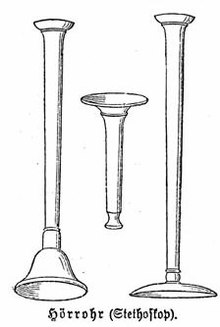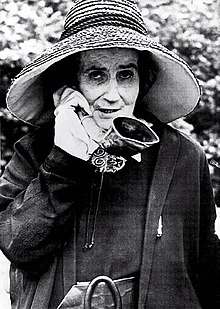Ear trumpet
Appearance


Ear trumpets are tubular or funnel-shaped devices which collect sound waves and lead them into the ear. This results in a strengthening of the sound energy impact to the eardrum and thus a better hearing for a reduced or decreased hearing.
Ear trumpets were made of sheet iron, silver, wood, snail shells or animal horns.
History
- 1624 - the French Jesuit priest and mathematician Jean Leurechon (1591–1670) writes Recreations mathématiques (with the pseudonym Henrik van Etten). The book gives the earliest known description of the operation of an ear trumpet.[1]
- 1650 - Athanasius Kircher which in addition to numerous other fields of knowledge with the science of sound and employed in 1650 in his Musurgia the invention of a "hearing machine" described, is regarded as the actual inventor of the stethoscope. The Roman physician Archigenes (2nd century), a stethoscope mentioned as a remedy for hearing loss, as was the Greek physician of Alexander Tralles (5th century). A medieval miniature from the 12th century that is now in the French National Library is, King Arthur's shows with a stethoscope in the hunt.
- 1706 - Duguet uses built-in tubes for receiving sound waves in the arms of a chair. This arrangement was repeated counterfeiting.[2]
- 1812 to 1814 - Johann Nepomuk Mälzel made ear trumpets for Ludwig van Beethoven. They are now kept in the Beethoven Museum in Bonn.
- 1816 - invented by René Théophile Hyacinthe Laënnec in France, the stethoscope to listen for heart sounds.
- 1879 - Rhodes constructed in Chicago from natural shells an audiophone which transferred sound vibrations through bone conduction by the subject held against the teeth or between the teeth.
- 1910 - The company Kirchner & Wilhelm in Asperg offered many stethoscope models in the catalog.
- 1963 - The ear trumpet producer F. C. Rein and Son in London ended activity as the last company of its kind.
